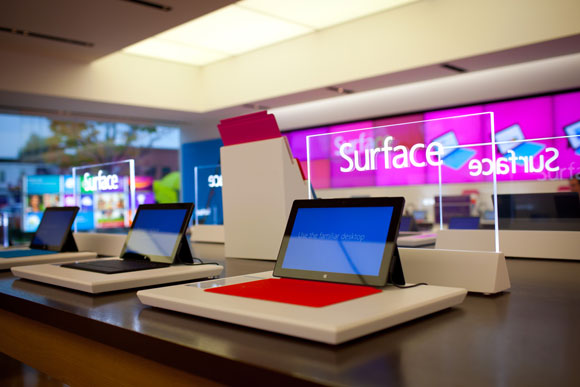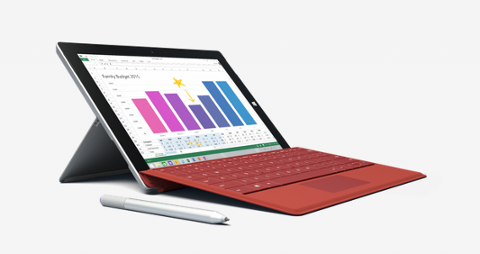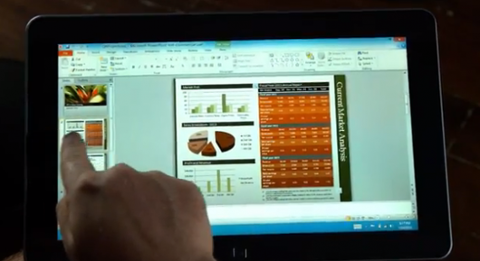 It’s difficult to overstate the importance of the Surface tablet to Microsoft’s overall fortunes in the consumer realm. If the device proves a resounding success, it could give Microsoft the momentum it needs to—in the words of CEO Steve Ballmer—become a full-fledged “devices and services” company. If Surface fails, on the other hand, it’ll add to the perception that Microsoft is becoming increasingly irrelevant among consumers, no matter how many licenses Windows 8 ends up selling to the broader market. The Surface device currently on the market runs Windows RT, a version of Windows 8 designed for devices powered by ARM architecture, which dominates the mobility segment. While Windows RT looks exactly like Windows 8, it can’t run Windows programs built for x86 processors, limiting users to what they can download from the built-in Windows Store app hub. Research firm IHS iSuppli has estimated Surface RT sales at more than a million units in the fourth quarter of 2012, according to CNET. While that number’s nothing to disregard out of hand, it lags well behind Apple’s iPad, which sold 14 million units last quarter. But research firm Detwiler Fenton offers a slightly lower estimate of total Surface RT sales—roughly 500,000 to 600,000 units, according to Forbes. Next month, Microsoft plans on launching Surface Pro, a version of the device running Windows 8 on an Intel Core i5 chip. Unlike Surface with Windows RT, it can actually run those Windows applications developed for x86 processors. However, the device will have approximately half the battery life of Surface RT, or around four hours. Surface Pro will also require buyers to put out a not-inconsiderable amount of cash: the 64GB version of the device will retail for $899, with the 128GB version coming in a little higher at $999. That’s considerably more expensive than other tablets on the market, not to mention a number of laptops. But Microsoft is betting big that Surface Pro’s support for Windows applications, and neat hardware features such as a flexible cover that couples as a keyboard, will give it that added boost among consumers and businesses looking for a touch-screen. Image: Microsoft
It’s difficult to overstate the importance of the Surface tablet to Microsoft’s overall fortunes in the consumer realm. If the device proves a resounding success, it could give Microsoft the momentum it needs to—in the words of CEO Steve Ballmer—become a full-fledged “devices and services” company. If Surface fails, on the other hand, it’ll add to the perception that Microsoft is becoming increasingly irrelevant among consumers, no matter how many licenses Windows 8 ends up selling to the broader market. The Surface device currently on the market runs Windows RT, a version of Windows 8 designed for devices powered by ARM architecture, which dominates the mobility segment. While Windows RT looks exactly like Windows 8, it can’t run Windows programs built for x86 processors, limiting users to what they can download from the built-in Windows Store app hub. Research firm IHS iSuppli has estimated Surface RT sales at more than a million units in the fourth quarter of 2012, according to CNET. While that number’s nothing to disregard out of hand, it lags well behind Apple’s iPad, which sold 14 million units last quarter. But research firm Detwiler Fenton offers a slightly lower estimate of total Surface RT sales—roughly 500,000 to 600,000 units, according to Forbes. Next month, Microsoft plans on launching Surface Pro, a version of the device running Windows 8 on an Intel Core i5 chip. Unlike Surface with Windows RT, it can actually run those Windows applications developed for x86 processors. However, the device will have approximately half the battery life of Surface RT, or around four hours. Surface Pro will also require buyers to put out a not-inconsiderable amount of cash: the 64GB version of the device will retail for $899, with the 128GB version coming in a little higher at $999. That’s considerably more expensive than other tablets on the market, not to mention a number of laptops. But Microsoft is betting big that Surface Pro’s support for Windows applications, and neat hardware features such as a flexible cover that couples as a keyboard, will give it that added boost among consumers and businesses looking for a touch-screen. Image: Microsoft How Many Surface Tablets Has Microsoft Sold?
 It’s difficult to overstate the importance of the Surface tablet to Microsoft’s overall fortunes in the consumer realm. If the device proves a resounding success, it could give Microsoft the momentum it needs to—in the words of CEO Steve Ballmer—become a full-fledged “devices and services” company. If Surface fails, on the other hand, it’ll add to the perception that Microsoft is becoming increasingly irrelevant among consumers, no matter how many licenses Windows 8 ends up selling to the broader market. The Surface device currently on the market runs Windows RT, a version of Windows 8 designed for devices powered by ARM architecture, which dominates the mobility segment. While Windows RT looks exactly like Windows 8, it can’t run Windows programs built for x86 processors, limiting users to what they can download from the built-in Windows Store app hub. Research firm IHS iSuppli has estimated Surface RT sales at more than a million units in the fourth quarter of 2012, according to CNET. While that number’s nothing to disregard out of hand, it lags well behind Apple’s iPad, which sold 14 million units last quarter. But research firm Detwiler Fenton offers a slightly lower estimate of total Surface RT sales—roughly 500,000 to 600,000 units, according to Forbes. Next month, Microsoft plans on launching Surface Pro, a version of the device running Windows 8 on an Intel Core i5 chip. Unlike Surface with Windows RT, it can actually run those Windows applications developed for x86 processors. However, the device will have approximately half the battery life of Surface RT, or around four hours. Surface Pro will also require buyers to put out a not-inconsiderable amount of cash: the 64GB version of the device will retail for $899, with the 128GB version coming in a little higher at $999. That’s considerably more expensive than other tablets on the market, not to mention a number of laptops. But Microsoft is betting big that Surface Pro’s support for Windows applications, and neat hardware features such as a flexible cover that couples as a keyboard, will give it that added boost among consumers and businesses looking for a touch-screen. Image: Microsoft
It’s difficult to overstate the importance of the Surface tablet to Microsoft’s overall fortunes in the consumer realm. If the device proves a resounding success, it could give Microsoft the momentum it needs to—in the words of CEO Steve Ballmer—become a full-fledged “devices and services” company. If Surface fails, on the other hand, it’ll add to the perception that Microsoft is becoming increasingly irrelevant among consumers, no matter how many licenses Windows 8 ends up selling to the broader market. The Surface device currently on the market runs Windows RT, a version of Windows 8 designed for devices powered by ARM architecture, which dominates the mobility segment. While Windows RT looks exactly like Windows 8, it can’t run Windows programs built for x86 processors, limiting users to what they can download from the built-in Windows Store app hub. Research firm IHS iSuppli has estimated Surface RT sales at more than a million units in the fourth quarter of 2012, according to CNET. While that number’s nothing to disregard out of hand, it lags well behind Apple’s iPad, which sold 14 million units last quarter. But research firm Detwiler Fenton offers a slightly lower estimate of total Surface RT sales—roughly 500,000 to 600,000 units, according to Forbes. Next month, Microsoft plans on launching Surface Pro, a version of the device running Windows 8 on an Intel Core i5 chip. Unlike Surface with Windows RT, it can actually run those Windows applications developed for x86 processors. However, the device will have approximately half the battery life of Surface RT, or around four hours. Surface Pro will also require buyers to put out a not-inconsiderable amount of cash: the 64GB version of the device will retail for $899, with the 128GB version coming in a little higher at $999. That’s considerably more expensive than other tablets on the market, not to mention a number of laptops. But Microsoft is betting big that Surface Pro’s support for Windows applications, and neat hardware features such as a flexible cover that couples as a keyboard, will give it that added boost among consumers and businesses looking for a touch-screen. Image: Microsoft 
